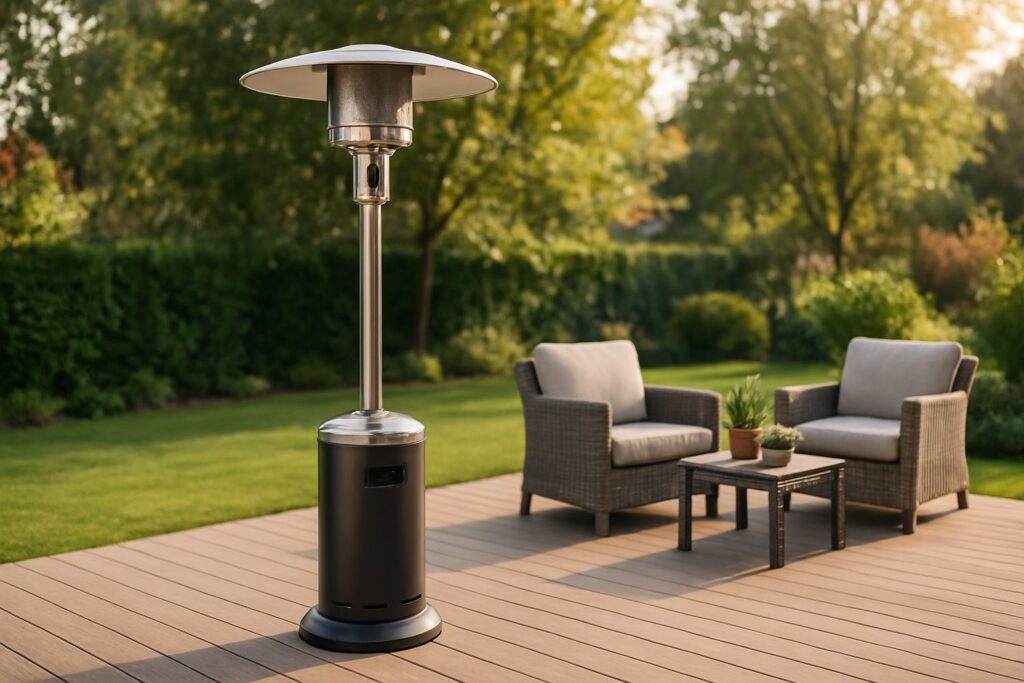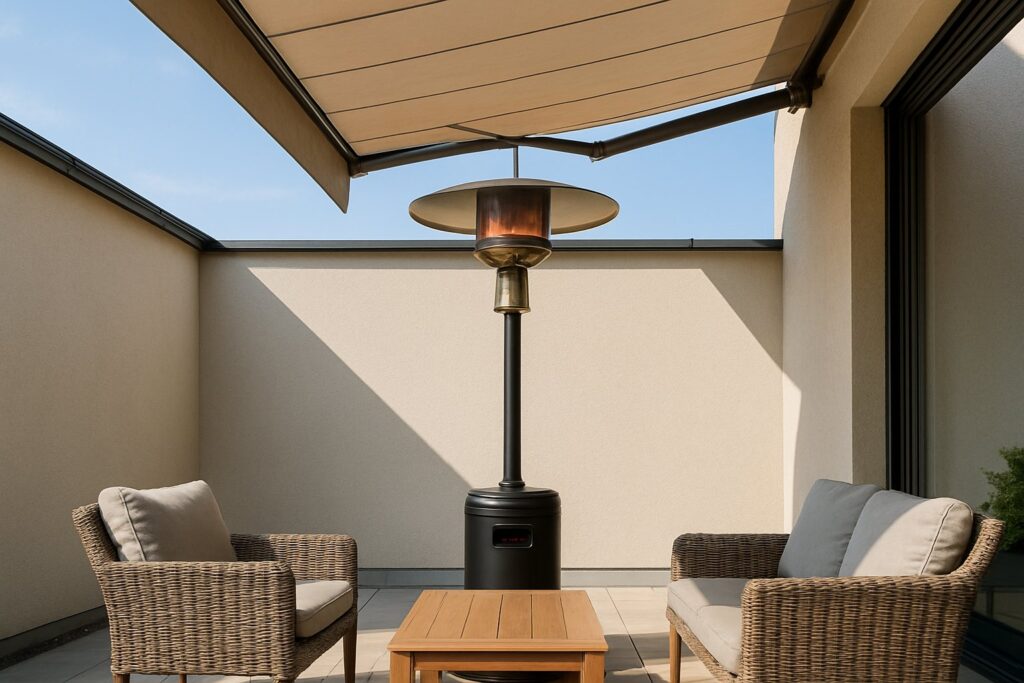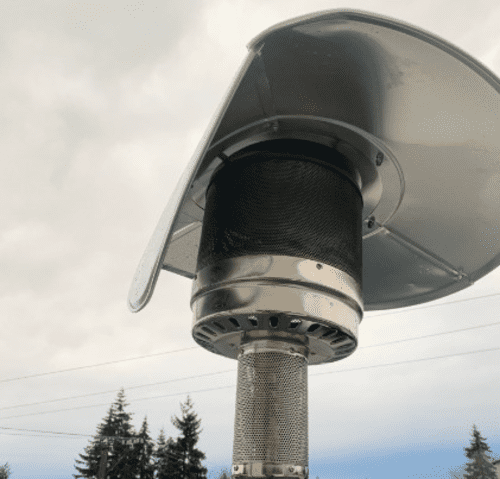Patio heaters transform outdoor spaces into year-round entertainment areas, but improper placement can create serious fire hazards and safety risks. Gas patio heaters require at least 4-5 feet of overhead clearance and 3 feet from walls and combustible materials, while electric models need 3 feet overhead and 18 inches from walls. These distances prevent overheating and reduce the risk of igniting nearby furniture, awnings, or structural elements.
The specific clearance requirements depend on multiple factors including heater type, BTU output, and installation location. Different heater models have varying heat signatures and safety specifications that directly impact how much space they need to operate safely. Understanding these requirements becomes particularly important when installing heaters under covered patios, near composite decking, or in semi-enclosed spaces.
Proper clearance planning involves more than measuring distances from ceilings and walls. The installation environment, ventilation needs, and local building codes all influence safe heater placement. Following manufacturer guidelines and established safety practices ensures outdoor heating systems provide warmth without compromising property or personal safety.
Understanding Patio Heater Clearance Requirements

Proper clearance distances prevent fire hazards and ensure safe operation of patio heaters. Different heater types require specific spacing from ceilings, walls, and combustible materials based on their heat output and fuel source.
Why Clearance Matters for Patio Heaters
Inadequate clearance around patio heaters creates serious fire risks and reduces heating efficiency. The intense heat generated by these units can ignite nearby combustible materials like furniture, awnings, or decorations.
Proper spacing allows heat to disperse evenly without accumulating in dangerous concentrations. This prevents overheating of surrounding surfaces and materials that could lead to fires.
Safety compliance requires following manufacturer guidelines and local building codes. Insufficient clearance can void warranties and create liability issues if accidents occur.
Heat circulation improves when adequate space surrounds the heater. This ensures optimal performance and extends the unit’s lifespan by preventing overheating of internal components.
Minimum Clearance Specifications by Heater Type
Gas patio heaters require the most clearance due to their high heat output and combustion gases. Freestanding gas models need 48 inches of patio heater ceiling clearance and 36 inches of patio heater wall clearance.
Tabletop gas heaters have reduced requirements with 24 inches overhead clearance and 18 inches from walls. Their lower BTU output allows for closer placement to surfaces.
Electric patio heaters need less space since they produce no combustion gases. Freestanding electric units require 36 inches of ceiling clearance and 18 inches from walls.
| Heater Type | Ceiling Clearance | Wall Clearance |
|---|---|---|
| Freestanding Gas | 48 inches | 36 inches |
| Tabletop Gas | 24 inches | 18 inches |
| Freestanding Electric | 36 inches | 18 inches |
| Wall-Mounted Electric | 12 inches | 6 inches |
Wood-burning heaters demand the greatest clearance with 60 inches from ceilings and 36 inches from walls due to their extremely high temperatures.
Ventilation and Combustible Material Considerations
Gas heaters require 25% of the surrounding area to remain open for proper ventilation. This prevents carbon monoxide buildup and ensures complete fuel combustion.
All combustible materials must stay at least 36 inches away from any patio heater. This includes fabric cushions, wooden furniture, plastic items, and dried vegetation.
Covered patios need additional ventilation considerations beyond standard clearances. Gas heaters should not operate in fully enclosed spaces without adequate air circulation.
Wind protection improves heater efficiency but cannot compromise ventilation requirements. Partial windscreens work better than full enclosures for gas-powered units.
Electric heaters offer more flexibility in semi-enclosed spaces since they produce no combustion gases. However, they still require clearance from combustible materials to prevent heat damage.
Ceiling, Wall, and Awning Clearances

Proper clearances around patio heaters prevent fire hazards and ensure safe operation. Gas heaters typically require 4-5 feet from ceilings, while electric models need 3 feet, and walls should maintain at least 3 feet of distance from any heater type.
Patio Heater Ceiling Clearance Standards
Gas patio heaters require a minimum ceiling clearance of 4-5 feet (1.2-1.5 meters) from any overhead combustible materials. This distance prevents overheating and reduces fire risks.
Electric patio heaters need at least 3 feet (0.9 meters) of ceiling clearance. Their lower heat output allows for reduced clearance requirements compared to gas models.
Wood-burning patio heaters demand the greatest ceiling clearance at 5 feet (1.5 meters) minimum. The open flame and higher heat output create additional safety concerns.
| Heater Type | Minimum Ceiling Clearance |
|---|---|
| Freestanding Gas | 48 inches (4 feet) |
| Freestanding Electric | 36 inches (3 feet) |
| Wood-Burning | 60 inches (5 feet) |
| Wall-Mounted Electric | 12 inches |
Heat deflectors can reduce gas heater ceiling clearance requirements to approximately 14 inches when properly installed.
Wall Clearance Guidelines
All patio heater types require a minimum 3 feet (0.9 meters) of clearance from walls and other combustible materials. This includes furniture, curtains, and decorative elements.
Electric heaters may operate safely with reduced wall clearance of 1.5 feet (18 inches) due to their lower surface temperatures and controlled heat output.
Gas heaters must maintain the full 3-foot clearance from walls to prevent heat accumulation and potential ignition of nearby materials.
Wall-mounted electric heaters need 6 inches of side clearance and should be positioned at least 48 inches above floor level.
The 3-foot rule applies to all combustible materials including wood structures, fabric awnings, outdoor cushions, and plant materials.
Awning Clearance for Patio Heater
Fabric awnings require the same clearance as ceiling materials – 4-5 feet for gas heaters and 3 feet for electric models. The combustible nature of most awning materials creates significant fire risks.
Retractable awnings should be fully retracted when operating gas patio heaters underneath. Even with proper clearance, wind can cause fabric movement that reduces safe distances.
Fixed awnings with proper clearance can accommodate patio heaters, but ventilation becomes critical. At least 25% of the covered area must remain open for gas heater operation.
Electric heaters work better under awnings due to their lower heat output and absence of combustion gases. They still require proper clearance but pose fewer ventilation concerns.
Metal awnings conduct heat efficiently, potentially creating hot surfaces even with adequate clearance. Monitor metal structures for excessive heat buildup during heater operation.
Installation Practices for Covered and Composite Deck Spaces
Installing patio heaters in covered areas requires additional overhead clearance and proper ventilation to prevent heat buildup. Composite decking surfaces need heat shields or protective barriers to prevent damage from direct heat exposure.
Patio Heater Under Covered Patio
Electric heaters work best under covered patios since they produce no combustion fumes. Gas heaters require at least 25% open area for proper ventilation to prevent carbon monoxide accumulation.
Overhead clearance increases significantly in covered spaces. Gas heaters need minimum 5 feet from any ceiling or overhead structure. Electric models require 3-4 feet depending on their BTU output.
Ventilation requirements become critical under pergolas, gazebos, or covered patios. The space must allow adequate airflow to disperse heat and fumes effectively.
Wall-mounted electric heaters offer better clearance control in covered areas. They maintain 12 inches overhead clearance and 6 inches side clearance while staying 48 inches above the floor.
Users should verify the manufacturer specifies their heater model for semi-enclosed spaces before installation.
Using Heat Shields on Composite Decks
Heat deflector plates protect composite decking from direct heat damage. These shields should extend 2-3 feet beyond the heater’s base in all directions.
Metal shields or ceramic tiles work effectively as protective barriers. They prevent heat transfer that could warp or discolor composite materials.
Elevated platforms raise heaters 6-12 inches above deck surfaces. This creates an air gap that reduces heat transfer to the decking below.
Clearance distances remain important even with shields. Heaters should maintain 3 feet from deck railings, furniture, and other combustible materials.
Regular inspection of shield placement ensures continued protection throughout the heating season.
Essential Patio Heater Safety Tips
Proper placement, adequate clearances, and regular maintenance form the foundation of safe patio heater operation. Following manufacturer guidelines and conducting routine inspections prevents accidents and ensures optimal performance.
Best Placement Practices
Choose a flat, stable surface for your patio heater installation. Uneven ground can cause the unit to tip over, creating fire hazards and potential injuries.
Position heaters away from high-traffic areas where people frequently walk. This prevents accidental contact with hot surfaces and reduces the risk of burns.
Avoid placing heaters in windy locations. Strong winds can destabilize gas flames, reduce heating efficiency, and potentially blow debris onto the unit.
Select areas with proper ventilation, especially for gas-powered models. Enclosed spaces require at least 25% of the area to remain open for adequate airflow.
Keep heaters away from doorways and exits to maintain clear evacuation routes. Emergency access should never be blocked by heating equipment.
Consider the direction of prevailing winds when positioning outdoor heaters. Wind patterns affect heat distribution and flame stability in gas models.
Safe Distances from Structures and Objects
Maintain 3 feet minimum clearance from walls, fences, and other structures. This distance prevents heat damage and reduces fire risks from radiant heat exposure.
Keep combustible materials at least 3 feet away from all sides of the heater. Items like outdoor cushions, decorations, and fabric covers must be positioned safely.
Overhead clearances vary by heater type:
- Gas heaters: 4-5 feet from ceilings
- Electric heaters: 3 feet minimum
- Tabletop models: 2 feet overhead space
Remove flammable debris like leaves, paper, and dry vegetation from the heater’s vicinity. Regular cleaning of the surrounding area prevents accidental ignition.
Position seating areas 24 inches minimum from the heater. This distance provides comfortable warmth while preventing burns from direct heat exposure.
Check for overhanging branches or structures that could catch fire. Trim vegetation and relocate any items that extend into the heater’s clearance zone.
Maintenance and Regular Inspection
Inspect gas connections monthly for leaks using soapy water. Bubbling indicates gas leaks that require immediate attention from qualified technicians.
Clean reflector shields and heating elements regularly to maintain efficiency. Dust and debris reduce heat output and can create fire hazards.
Check propane tank connections before each use. Ensure fittings are tight and examine hoses for cracks, wear, or damage that could cause gas leaks.

Replace worn components immediately, including damaged hoses, corroded fittings, and cracked reflectors. Using damaged parts compromises safety and performance.
Store portable heaters properly during off-seasons. Clean thoroughly, disconnect fuel sources, and protect from weather damage in covered areas.
Schedule professional servicing annually for gas heaters. Qualified technicians can identify potential problems and ensure safe operation throughout the heating season.
Verify safety features function correctly, including tip-over switches and flame sensors. Test these mechanisms regularly to ensure they activate when needed.
Written by Outdoor Space & Accents, very own Will in his practical, safety-first guidance based on manuals, CSA/UL norms, and real-world use.


